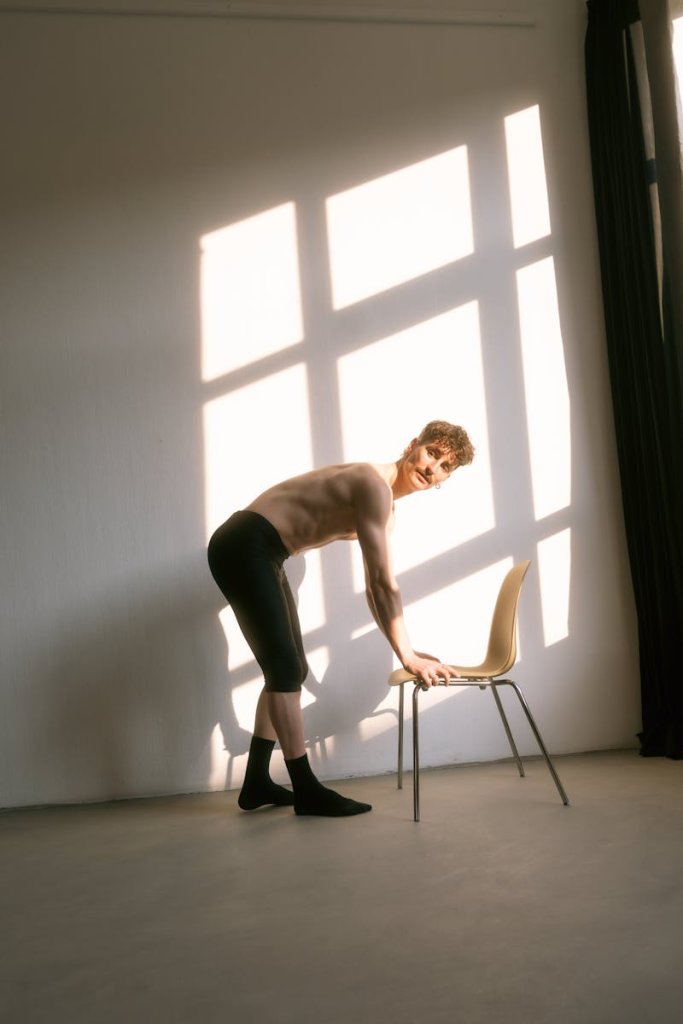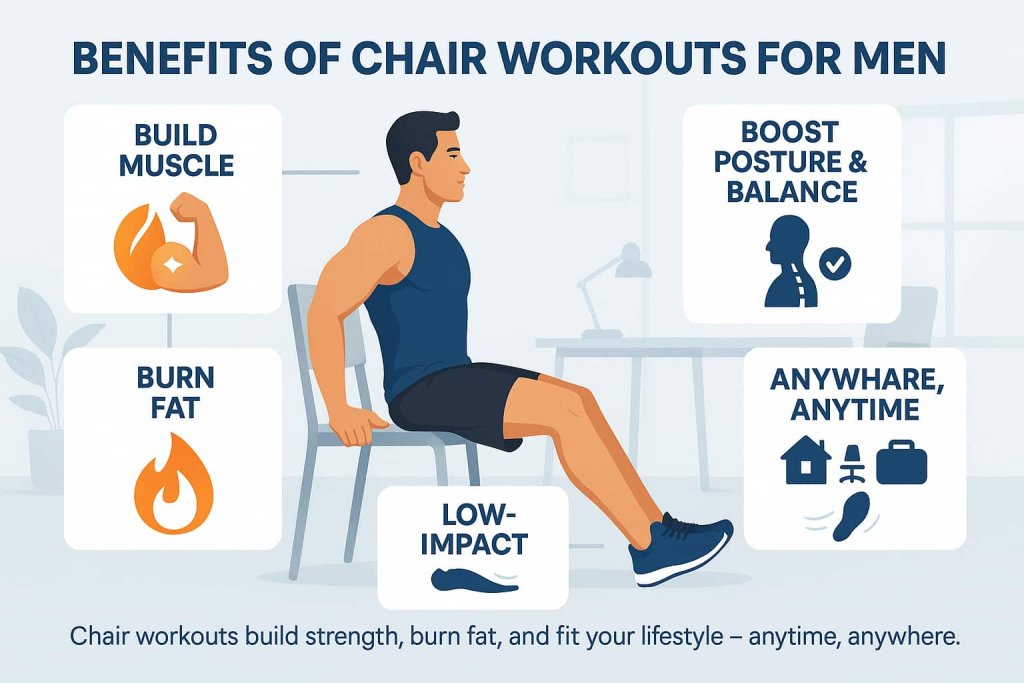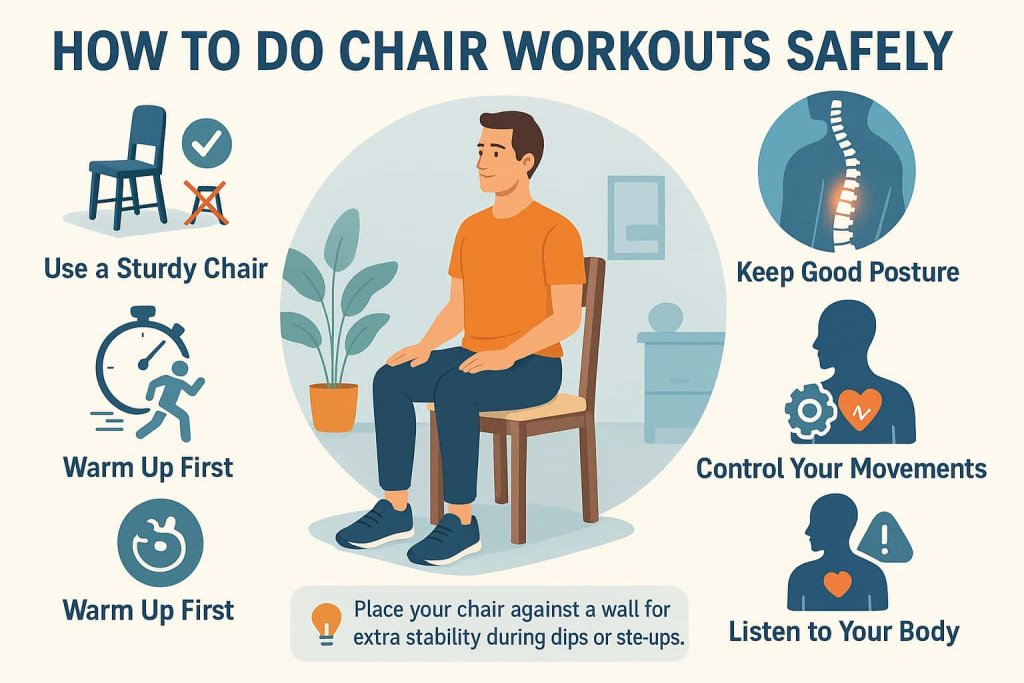Yes — men can build muscle and burn fat right from a chair.
Chair workouts use your body weight, stability, and controlled resistance to strengthen muscles, improve posture, and torch calories — all without gym equipment.

Whether you work long hours at a desk, travel often, or simply prefer at-home fitness, these chair exercises make strength and fat-loss training accessible and joint-friendly.
This guide covers 15 of the best chair workouts for men, targeting full-body muscle activation while helping you stay lean and powerful.
Benefits of Chair Workouts for Men
Chair workouts aren’t just for rehabilitation or seniors — when done with intensity and control, they deliver serious fitness results.

Key Benefits:
- Build muscle: Engage large muscle groups (legs, chest, core, arms) with resistance and tempo.
- Burn fat: Fast circuits elevate heart rate for steady-state calorie burn.
- Boost posture and balance: Strengthen stabilizers and core to counteract sitting fatigue.
- Low-impact: Easier on joints than jumping or heavy lifting.
- Anywhere, anytime: Perfect for home, office, or travel routines.
📘 Evidence:
A systematic review of 1,388 participants found chair-based programs significantly improved strength and functional capacity, and recent studies measuring the energy cost of seated routines show they can meaningfully raise effort above rest—supporting chair workouts as a practical training option for home or office.
How to Do Chair Workouts Safely
Before starting, make sure your setup and form are on point to prevent injury and get better results.

- Use a sturdy chair: Pick a non-rolling, armless chair on a flat surface.
- Keep good posture: Sit tall, core tight, shoulders relaxed, and feet flat.
- Warm up first: Do 5–7 minutes of light cardio or dynamic stretches to activate muscles.
- Control your movements: Avoid jerking or swinging — move slow and steady.
- Listen to your body: Stop if you feel sharp pain or dizziness.
💡 Pro Tip: Place the chair against a wall for extra stability during dips or step-ups.
15 Best Chair Workouts for Men
Each movement below includes the why, muscles worked, how to do it, and a trainer tip to perfect your form.
1. Seated Leg Extensions
Why it works:
This foundational lower-body movement isolates the quadriceps, which are responsible for knee extension and lower-body stability. By extending your legs against gravity, you strengthen the muscles that support running, squatting, and stair climbing. Regular practice improves knee health, enhances athletic performance, and tones the thighs — a must for men who sit long hours.
Muscles worked: Quadriceps (rectus femoris, vastus lateralis, vastus medialis), hip flexors.
How to do it:
- Sit upright on the chair with your back supported and core tight.
- Place both feet flat on the floor, hip-width apart.
- Extend one leg until it’s straight in front of you, keeping toes flexed upward.
- Squeeze your quadriceps at the top for 1–2 seconds.
- Slowly lower back down without letting your foot touch the floor.
- Alternate legs or perform both simultaneously for balance training.
Trainer Tip:
Add ankle weights, resistance bands, or even a weighted backpack on your thighs to increase muscle activation. Perform the lowering phase slowly (3–4 seconds) to build more strength.
2. Chair Dips
Why it works:
Chair dips are a compound bodyweight exercise that build strong, defined triceps while also activating the chest and shoulders. They’re a powerful home alternative to parallel bar dips and ideal for men aiming to build upper-body strength using minimal equipment.
Muscles worked: Triceps brachii, pectoralis major, anterior deltoids.
How to do it:
- Sit at the front edge of the chair and grip the seat beside your thighs.
- Extend your legs forward, keeping your heels on the floor.
- Slide your hips off the seat and lower yourself by bending elbows to 90°.
- Press through your palms to lift back to the starting position.
Trainer Tip:
Keep your elbows tucked close to your body and shoulders pulled back. Avoid dipping too low to protect your shoulders. For more challenge, place your feet on another chair or bench.
3. Seated Shoulder Press
Why it works:
This move builds shoulder mass, triceps strength, and upper-body stability while engaging the core for posture. Performing it seated eliminates momentum and isolates the deltoids more effectively.
Muscles worked: Anterior and medial deltoids, triceps, upper chest, core stabilizers.
How to do it:
- Sit upright, feet flat on the floor.
- Hold dumbbells at shoulder height, palms facing forward.
- Press both weights overhead until arms are straight.
- Pause, then lower under control until elbows are at shoulder level.
Trainer Tip:
Don’t arch your lower back — engage your core and keep your spine neutral. Use a controlled tempo (2 seconds up, 3 seconds down).
4. Chair Squats
Why it works:
A hybrid of a standard squat and a sit-to-stand movement, this exercise strengthens the legs and glutes while teaching correct hip movement patterns. It’s joint-friendly and helps boost calorie burn.
Muscles worked: Gluteus maximus, quadriceps, hamstrings, calves, core.
How to do it:
- Stand with your back to the chair, feet shoulder-width apart.
- Push hips back and bend knees as if sitting, keeping your chest upright.
- Lightly tap the chair with your glutes (don’t sit fully).
- Drive through heels to return to standing.
Trainer Tip:
Focus on controlling the descent — this eccentric phase stimulates more strength. Add dumbbells or a weighted backpack for added resistance.
5. Seated Knee Tucks
Why it works:
This movement strengthens the entire core, focusing on the lower abdominals and hip flexors. It’s an excellent choice for improving stability, posture, and fat reduction around the midsection.
Muscles worked: Rectus abdominis, transverse abdominis, hip flexors, obliques.
How to do it:
- Sit on the front edge of the chair with hands gripping the sides.
- Lean slightly back without resting on the backrest.
- Bring both knees toward your chest while exhaling.
- Extend legs straight without letting feet touch the floor.
Trainer Tip:
Keep the motion controlled and deliberate. Avoid swinging — focus on contracting your abs with each rep.
6. Seated Bicep Curls
Why it works:
This isolation move enhances arm strength and definition, helping men build thicker, stronger biceps without heavy weights. Performing curls seated reduces body sway and ensures full control.
Muscles worked: Biceps brachii, brachialis, forearm flexors.
How to do it:
- Sit upright with your elbows tucked against your torso.
- Hold dumbbells or resistance bands at arm’s length.
- Curl the weights toward your shoulders, squeezing at the top.
- Lower slowly until arms are fully extended.
Trainer Tip:
Rotate your wrists outward (supinate) as you lift for better biceps activation. Exhale as you curl, inhale on the way down.
7. Chair Plank
Why it works:
A modified plank that protects wrists and improves core endurance. It enhances posture and builds overall core strength — the foundation of all athletic movement.
Muscles worked: Core (rectus abdominis, obliques), shoulders, chest, glutes.
How to do it:
- Place your hands on the chair seat, shoulder-width apart.
- Step your feet back until your body forms a straight line.
- Engage your abs, squeeze your glutes, and hold for 20–60 seconds.
Trainer Tip:
Keep your gaze slightly forward, not down. Avoid arching your back — your body should form a single line from head to heels.
8. Seated Russian Twists
Why it works:
A dynamic rotational exercise that tones the obliques and improves trunk mobility, making it a perfect core finisher.
Muscles worked: Obliques, rectus abdominis, hip flexors.
How to do it:
- Sit at the front edge of the chair with feet lifted slightly off the floor.
- Hold a dumbbell, water bottle, or medicine ball with both hands.
- Twist your torso from side to side, keeping your core braced.
Trainer Tip:
Move slowly through each twist. Fast, jerky motions reduce muscle engagement and can strain your back.
9. Chair Step-Ups
Why it works:
Chair step-ups mimic climbing stairs — an outstanding functional exercise for developing lower-body strength, balance, and stability.
Muscles worked: Glutes, hamstrings, quadriceps, calves.
How to do it:
- Stand facing the chair with feet hip-width apart.
- Step one foot firmly on the seat, driving through your heel to stand.
- Bring the other leg up to the chair, then step back down slowly.
- Alternate legs.
Trainer Tip:
Keep your chest up and core engaged. For intensity, hold dumbbells or increase speed for a cardio burn.
10. Seated Overhead Triceps Extension
Why it works:
A targeted move that sculpts the back of the arms and boosts pressing power for other upper-body exercises.
Muscles worked: Triceps brachii (long head and lateral head), shoulders.
How to do it:
- Sit tall with your spine straight.
- Hold one dumbbell vertically with both hands above your head.
- Lower it behind your head until elbows reach a 90° bend.
- Press back to full extension.
Trainer Tip:
Keep your elbows close to your head — avoid flaring. Squeeze at the top for maximum contraction.
11. Seated Marches
Why it works:
An accessible, low-impact movement that increases circulation, activates your core, and improves coordination — perfect as warm-up or active recovery.
Muscles worked: Hip flexors, abs, quads, lower back.
How to do it:
- Sit upright and lift one knee toward your chest.
- Lower and repeat with the opposite leg in a smooth marching rhythm.
- Continue alternating for 30–60 seconds.
Trainer Tip:
For intensity, speed up the pace or lift knees higher. Keep your torso still to isolate your core.
12. Seated Lateral Raises
Why it works:
A key isolation exercise for creating broader shoulders and balanced upper-body strength.
Muscles worked: Lateral deltoids, upper trapezius.
How to do it:
- Sit with dumbbells at your sides, elbows slightly bent.
- Raise arms outward until shoulder height.
- Lower slowly for 3 seconds.
Trainer Tip:
Keep movements controlled — avoid shrugging your shoulders. The slower your descent, the greater the muscle activation.
13. Seated Calf Raises
Why it works:
Strengthens and tones the calves, improves balance, and supports athletic performance by increasing ankle stability.
Muscles worked: Gastrocnemius, soleus.
How to do it:
- Sit upright with feet flat on the ground.
- Lift your heels as high as possible, pause at the top.
- Lower slowly until heels touch the floor.
Trainer Tip:
Hold a dumbbell, heavy book, or weighted backpack on your knees for added resistance. Perform slow, full-range repetitions.
14. Seated Reverse Fly
Why it works:
A posture-correcting movement that strengthens the upper back and rear shoulders — countering forward-rounded shoulders common in desk work.
Muscles worked: Rear deltoids, rhomboids, middle trapezius.
How to do it:
- Sit with feet flat and hinge forward at hips.
- Hold dumbbells beneath your knees with palms facing each other.
- Lift both arms out to the sides until parallel to the floor.
- Squeeze shoulder blades together, then lower slowly.
Trainer Tip:
Keep the weights light and focus on precision. This move is about activation, not load.
15. Chair Burpees (Modified)
Why it works:
A fat-scorching, full-body move adapted for safety and accessibility. It combines cardio, strength, and endurance — ideal for fat loss and metabolic conditioning.
Muscles worked: Chest, legs, shoulders, triceps, core.
How to do it:
- Stand facing the chair, hands on the seat.
- Step or jump feet back into a plank.
- Step forward, stand tall, and add a small jump.
- Repeat at a steady rhythm for 30–60 seconds.
Trainer Tip:
Keep movements fluid and controlled. As you improve, speed up transitions to boost calorie burn.
Sample Chair Workout Routine
| Level | Focus | Routine Example | Frequency |
|---|---|---|---|
| Beginner | Form & Control | 8–10 moves × 2 sets | 3× per week |
| Intermediate | Strength & Endurance | 12–14 moves × 3 sets | 4× per week |
| Advanced | Power & Fat Burn | All 15 moves × 4 sets | 4–5× per week |
💡 Pro Tip: For fat loss, perform exercises in circuit style — minimal rest between moves, 30 sec on / 15 sec off.
Safety Tips and Modifications
- Use a sturdy, non-rolling chair on flat surface.
- Maintain upright posture — avoid slouching or rounding your back.
- Warm up for 5 minutes (marching, shoulder rolls).
- Adjust intensity: slow down or shorten range if new; add weights when stronger.
- Stop immediately if you feel sharp pain or dizziness.
FAQs
1. Can chair workouts really build muscle?
Yes. With slow tempo and added resistance (bands or weights), you can achieve effective hypertrophy and toning.
2. How many times per week should I do chair workouts?
Aim for 3–5 sessions weekly, alternating strength and cardio days.
3. What equipment can I add?
Use resistance bands, light dumbbells, or ankle weights for progression.
4. Are chair workouts safe for knees and back?
Yes — they are low-impact and great for joint health if posture is maintained.
5. Can I lose weight with chair exercises?
Combined with a calorie-controlled diet, high-intensity chair circuits can burn 200–300 calories in 30 minutes.
6. What type of chair should I use?
A sturdy, armless, non-swivel chair is best for stability and range of motion.
7. Can beginners start with these moves?
Absolutely — start with body-weight versions and focus on form before adding resistance.
Conclusion
Chair workouts prove that fitness doesn’t require fancy equipment or long gym sessions.
With just a stable seat and your determination, you can build muscle, burn fat, and reclaim your health anywhere.
👉 Start today: choose five moves from this list and perform them 3–4 times per week.
Consistency — not the gym — builds results.
